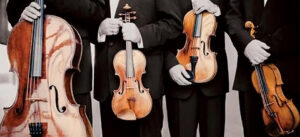
10. Albatrosses
This may seem a little far afield, but bear with me. There are two choices for the plural of albatross. The first is albatross, as in “At least twenty albatross whizzed about our sails, excited about our prospective catch,” and the alternate plural, as in “Albatrosses mate for life.” I prefer the second, since I am about to spend some time thinking about string quartets, which also often mate for life.
As we move along in this journey of introducing your dog to classical music (and of course, if some of these explorations have sparked a little interest in a child or two, that’s okay) it might be worthwhile to pause here in the valley, climb up on that little hill over there, and get the lay of the entire terrain around us. The world of classical music is vast, but not infinite. And there is one kind of music that might consistently offer the greatest peaks. I think it would be worthwhile if you knew about them now, so you can try a sample here and there, and see how some of these masterpieces work for you.
‘String quartets’ is both the name of a type of composition, and is also the name for the groups that play them. The groups, or ensembles, made up of a first and second violin, a viola, and a cello, often stay together for the entire life of the players. They typically become embryonic in music school when young string players start playing quartets, and if four players find they have an affinity for both the music and each other, they make a commitment. Their names can be the Busch Quartet, or the Guarneri Quartet, or the Amadeus or the Ying. In every case you are looking at four people committing their lives to creating a complex musical voice devoted to a unique musical literature.
Which came first, the players or the music? The musical form itself, and credit for creating the structure and exploring its potential goes to Joseph Haydn, who wrote 68 string quartets, providing the template for Mozart and Beethoven who knew Haydn and greatly admired him.
Beethoven reserved his most abstract and complex writing for his quartets. They were in many ways his musical laboratory where he could develop a music that might be even too abstract for his mass audiences. Beethoven specifically said that his late quartets were actually written for you, an audience that was decades or centuries away. He held no expectation they would be understood during his lifetime, and, generally, that turned out to be true.
A few years ago when I was at lunch with an author, he brought up a new core idea he was thinking about — he was considering that God actually showed up in the arts from time to time throughout history, moving from one artist to another, resulting in a series of masterpieces that defined civilization. His feeling was that even for the greatest of artists there were moments of inspiration that were such enormous leaps that they could only have been divine. He then said, “Beethoven, for example…” I couldn’t help but interrupt with my guess, “One thirty-one.” The author raised a knowing eyebrow. “Exactly,” he nodded, resting his case.
What in the world was this strange conversation? Even though the two of us had never discussed music before, it was obvious to me where he was headed. Because Beethoven’s String Quartet Number 14, also known as Opus (work) 131, has always been so complex, so mysterious, that it seems to be revealing its secrets to us from the first time we hear it and then ever after throughout our lifetimes. It’s something like a Talmudic commentary, with layer upon layer of interpretation and meaning that can only unfold as we somehow change — and it seems to lead us in that journey.
I hope I have intrigued you here and not lost you. For I am saying here is a piece of music that may be the most difficult masterpiece to thoroughly grasp, and yet I’m suggesting that you might want to hear it early on in your discovery of string quartets. I suggest you might try not to have any expectations or even too much interest. Just let it play for its forty minutes, notice some things or not. Approach the 131 as you might the sun: don’t look at it directly for the moment. Just listen to it once and forget about it for a few months. And then, after you’ve listened to a number of other string quartets, come back to the131 and let Beethoven show you how the future, in other words — us — looked to him just about two hundred years ago.
There are two ways to explore string quartets, depending on how you like to go about things — vertical and horizontal. A vertical exploration would take you from Haydn, to Mozart, to Beethoven and eventually wind your way through the 19th, 20th, and this century. There are a few giants along the way, and I will list them in a moment so you have a guide.
Another approach would be horizontal: find a period of music that you already like and then look for the quartets in it. If you and the hound were enthusiastic about the Brahms Horn Trio from a few chapters ago, you might want to start with one of his three quartets. I would suggest the Second in A minor. Although you may love them, I have never been able to get comfortable with any of them. So if you’re starting with Brahms, born in 1833, you may next want to go a few years earlier and sample some Beethoven, who was born in 1770.

In the hands of the Tokyo String Quartet, the set of Stradivari instruments known as ‘The Paganini Quartet’ (l—r) the ‘Ladenburg’ Cello, the ‘Desaint’ Second Violin, the ‘Mendelssohn’ Viola, and the ‘Conte Cozio di Salabue’ First Violin
If in the Storm chapter you found yourself enthralled by Debussy’s soundworld in La Mer, then try the string quartet by his contemporary, Maurice Ravel, who wrote but one quartet, known at the F Major, which is simply ravishing. Try to find the Lindsay Quartet’s performance.
Now for a vertical approach. Since Haydn’s establishment of the string quartet form, a few composers have built the core of their musical thinking on their own quartets. Some of these ‘bodies of work’ have become the anchors of the entire world of string quartets.
These are the big contributors, after Haydn: Beethoven — 16 quartets. Start anywhere, they are all splendid. Schubert wrote at least 15. The 14th, known as Death and the Maiden, has been the backbone for many movies and documentaries. It is gorgeous. The rest of the 19th century offers lots of lovely quartets, but not until Béla Bartók began his cycle of 6 quartets in 1901 did a major composer completely change the soundscape of what these four instruments could do together. When you’re ready for these ‘modern’ quartets, start at the beginning and go right through them. I would also strongly recommend finding a live performance (by ‘live’ I mean you actually have to go there and be in the same room) of any of the Bartók quartets, since it makes a big difference in following all their complexities and colors to actually watch each player do what they do to create Bartók’s vast color palette.
Dmitri Shostakovich, living most of his life within the confines of Soviet communism, wrote 15 quartets beginning in 1938, and each is compelling, harrowing and beautiful, each in its own way. The performance of the complete works that has been most satisfying for me is that of the Alexander Quartet. Again, if you have the opportunity to hear any Shostakovich quartet played live, take advantage of the opportunity. Any decent performance will generally be an emotional wipe out.
Many of the string quartet performers that initially got together to perform the masterpieces from Haydn, Beethoven, Mozart and Dvořák, eventually fund new composers to create new quartets. Over the last half of the 20th century and right up to yesterday, these new works keep pouring forth. So if you want to listen to the latest and greatest classical music written for your era, one of the best ways to go about it is to find a string quartet you like and see what new works they’ve been commissioning and playing. Visit the websites of the Kronos, Pacifica, the St. Lawrence and many other quartets. Or just search “string quartet commissions,” and you will discover a motherlode of contemporary musical riches.
I have a go-to quartet for new music because I love their sensibilities — the Ying Quartet, who have been commissioning new work since 1999. The first record I heard by them was Life Music, with four works written in 1999 and 2000 by young composers Kevin Puts, Michael Torke, Carter Pann and Paquito D’Rivera. This is a CD that, in our house, we turn to again and again. A wonderful ear cleanser, refreshing and just beautiful.
A later Ying Quartet album, recorded in 2007, called Dim Sum, brought the music of contemporary Chinese composers into the string quartet world, with delightful results.
If you’d like to read a novel that captures some of the intensity of what it takes to form and sustain a string quartet and what happens in those thousands of hours of rehearsal as every note and phrase is discussed, worked, and reworked until there is a meld of four musicians into one view, one performance, then I’d like to suggest An Equal Music: A Novel by Vikram Seth. The book might be something delightful to read while making your quartet explorations. Seth also put together a double CD with great performances of all the music in the book. The whole thing is quite a treat. I can’t find the set on Amazon or Idagio, but it is Decca UN 925 and available used at discogs.com.
When I was in high school, a friend invited me to join her at a grand mansion along the Cleveland lakeshore, where her cousin, a young violinist, was preparing for a major violin competition. The violinist was Arnold Steinhardt, who went on to win the competition (the Leventrit) and was for many decades the first violinist of the Guarneri Quartet. That summer Arnold was being presided over by his mother, who gained fame for a motherly remark, “Arnold. You look tired. Why don’t you lie down. And practice.” (Update: I pinged Arnold and he informed me that a friend of his made up this story. When his mother heard about it, she said. “I didn’t say it, but I could have.”)
Arnold has written two superb books about music. The first is Divided by Four about life inside the Guarneri Quartet. The second, Violin Dreams, comes with a CD performed by Steinhardt and is a collection of delightful essays about music and his travels and thoughts as a world-stomping performer. Highly recommended.
The string quartet is a body of music that often offers the deepest insight into a composer’s most exposed self. The musical literature of its world is filled with masterpieces, and any composer or performer venturing here knows they will be judged by the giants preceding them. There is no casual string quartet. Once we have become familiar with its territory we will always know where to go when we are in search of greatness.
